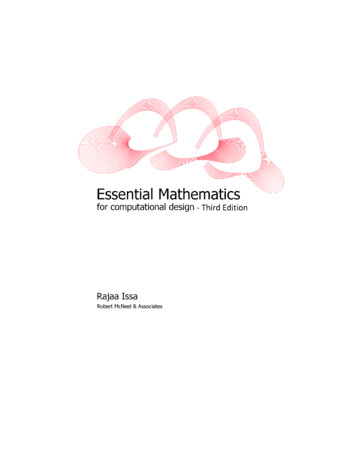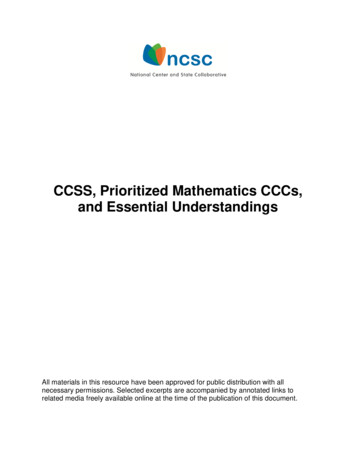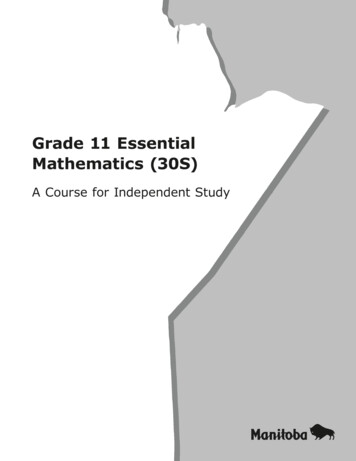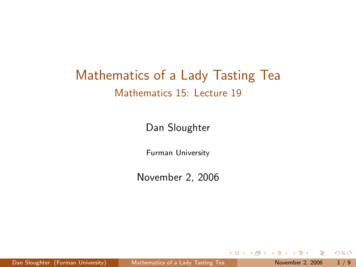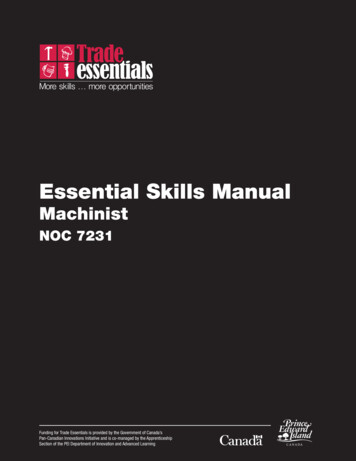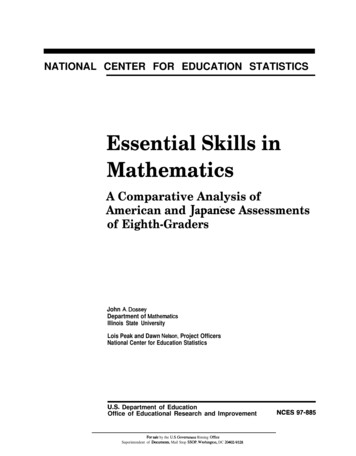
Transcription
NATIONAL CENTER FOR EDUCATION STATISTICSEssential Skills inMathematicsA Comparative Analysis ofAmerican and Japanese Assessmentsof Eighth-GradersJohn A. DosseyDepartment of MathematicsIllinois State UniversityLois Peak and Dawn Nelson, Project OfficersNational Center for Education StatisticsU.S. Department of EducationOffice of Educational Research and ImprovementFor sale by the U.S. Ckwemment Riming OfficeSuperintendent of Dncuments, Mail Stop SSOP, Wadungton, DC 20402-932SNCES 97-885
U.S. Department of EducationRichard W. RileySecretatyOffice of Educational Research and ImprovementMarshall S. SmithActing Assistant Secreta National Center for Education StatisticsPascal D. Forgione, Jr.CommissionerThe National Center for Education Statistics (NCES) is the primary federal entity for collecting,analyzing, and reporting data related to education in the United States and other nations. Itfulfills a congressional mandate to collect, collate, analyze, and report full and completestatistics on the condition of education in the United States; conduct and publish reports andspecialized analyses of the meaning and significance of such statistics; assist state and localeducation agencies in improving their statistical systems; and review and report on educationactivities in foreign countries.NCES activities are designed to address high prioriy education data needs; provide consistent,reliable, complete, and accurate indicators of education status and trends; and report timely,useful, and high quality data to the U.S. Department of Education, the Congress, the states,other education policymakers, practitioners, data users, and the general public.We strive to make our products available in a variety of formats and in language that isappropriate to a variety of audiences. You, as our customer, are the best judge of our successin communicating information effectively. If you have any c6mments or suggestions about thisor any other NCES product or report, we would like to hear from you. Please direct yourcomments to:National Center for Education StatisticsOffice of Educational Research and ImprovementU.S. Department of Education555 New Jersey Avenue NWWashington, DC 20208-5574April 1997The NCES World Wide Web Home Page ishttp:/Avww.ed.govlNC ESISuggested CitationU.S. Department of Education. National Center for Education Statistics. Essential Skills inMathematics: A Comparative Analysis of American and Japanese Assessments ofEighth-Gmders, NCES 97-885, by John A. Dossey. Lois Peak and Dawn Nelson, ProjectOfficers. National Household Education Survey, Washington, DC: 1997.Each year the National Center for Education Statistics (NCES) commissions papers byrecognized experts on topics of interest. These ppers are published by NCES to preserve theinformation contained in these documents and to promote the sharing of valuable workexperience, unique expertise, and knowledge. However, these papers do not undergo vigorousNCES publication review and editing prior to their publication. The conclusions, opinions,and/or recommendations contained in the pers are those of the authors and do notnecessarily reflect the views of NCES or the U.S. Department of Education. Consequently, weencourage readers of the papers to contact the individual authors regarding questions and forcitations.Contact:Dawn Nelson(202) 219-1740
AcknowledgmentsThe present report was completed in 1996 and is the result of significant input from a number ofindividuals. Lois Peak at the National Center for Education Statistics (NCES) initiated the study and suggestedimportant frames of reference throughout the early stages of its development.Along the way, I profited by continued input from Sayuri Takahira who carefully translated the Japaneseresults and provided interpretive guidance on exact meanings of several terms. Colleagues, including EizoNagasaki, Toshio Swada, and Hanako Senuma, at the National Institute for Educational Research at theMinistry of Education in Tokyo, Japan, also provided input and helpful assistance at points in the analysis ofresults and interpretations of the curriculum in Japan. Similar input was received from Steve German andSharif Shakrani who reviewed the document at NCES and from Mary M. Lindquist, Call away Professor ofMath Education at Columbus State University.Ina Mull is (formerly at the National Assessment of Educational Progress Center at Educational TestingService (ETS) and now at Boston College) and Chan Jones and Jeff Haberstroh at ETS provided support inidenti ing and classi ing comparable items from the NAEP item pool for comparative analysis. Pat Kenneyof the University of Pittsburgh’s Learning Research and Development Center’s NCTM/NAEP InterpretiveProject provided helpful assistance in tracking down elusive p-values for several items.Dawn Nelson at NCES carefull y guided the report through its final development and publ ication processat NCES. And last, but not least, my wife Anne assisted through data analysis, proof-reading, and providedother forms of support across the span of the project,.Ill
ContentsAcknowledgments. . . . . . . . . . . . . . . . . . . . . . . . . . . . . . . . . . . . . .Chapterandl:Data. . . .1. . . . . . . . . . . . . . . . . . . . . . . . . . . . . . . . . . . . . . .1. . . . . . . . . . . . . . . . . . . . . . . . . . . . . . . . . . . . . ftheStudies . . . . . . . . . . . . . . . . . . . . . . . . . . . . . . . . . . .2Chapter2:TheMathematicsAssessments. . . . . . . . . . . . . . . . . . . . . . . . . .7. . . . . . . . . . . . . . . . . . . . . . . . . . . . . . . . . .8JapaneseContentTests. . . . . . . . . . . . . . . . . . . . . . . . . . . . . . . . . . .9NAEPContentTestsItems. . . . . . . . . . . . . . . . . . . . . . . . . . . . . . . . . . . . .13NumbersandOperations. . . . . . . . . . . . . . . . . . . . . . . . . . . . . . . .13. . . . . . . . . . . . . . . . . . . . . . . . . . . . . . . . . . . . . .14Geometry. . . . . . . . . . . . . . . . . . . . . . . . . . . . . . . . . . . . . . . .15DataStatistics,.24. . . . . . . . . . . . . . . . . . . . . . . . . . . . . . . . . ionsandProbability.Chapter4:ARetrospectiveView . . . . . . . . . . . . . . . . . . . . . . . . . . . . . . . . . . . . . . . . . . . . . . . . . . . . . . . . . . . . . . . . .37. . . . . . . . . . . . . . . . . . . . . . . . . . . . . . . . . . . . .38. . . . . . . . . . . . . . . . . . . . . . . . . . . . . . . . . . .39. . . . . . . . . . . . . . . . . . . . . . . . . . . . . . . . . . . . . . . . . erences37Appendix A: Content Matrix for the 1992 NAEPMathematics Assessment . . . . . . . 43Appendix B: Mathematical Abilities forthe 1992 NAEPMathematics Assessment . . .53Appendix C: Framework forthe Japanese Essential Mathematics Assessment . . . . . . 57v
Chapter 1: Background and PurposeIntroductionThe definition of essential skills in mathematics has long been a goal of mathematics educators andothers interested in the school mathematics curriculum. From the late 1970s forward, attempts have beenmade in the United States to provide a framework defining the basic essentials of mathematics that all studentsshould know and be able to apply (National Council of Supervisors of Mathematics, 1977; National Councilof Teachers of Mathematics, 1980, 1981). Such recommendations for new directions in school mathematicscalled for a broader view of content and, in general, an increased emphasis on the development of studentabilities to solve non-routine problems. These changes brought incremental changes in classrooms wherethe overall focus remained on number work and teacher dominated discussion of mathematics. In the late1980s, the Nat ional Counci I of Teachers of Mathematics (NCTM) produced its Curriculum and EvaluationStandardsforSchoo/ Mathematics (NCTM, 1989). This document was designed to help strengthen the effortsin the United States toward developing foci for the mathematics curriculum. While its goals have yet to beimplemented on a wide scale basis (Weiss, 1995), it has influenced changes made in the definition ofmathematics used for the Department of Education’s National Assessment of Education Progress (NAEP)mathematics assessments (NAEP, 1987, 1988).Over this same period of time, from the 1970s through the 1980s, there was increasing evidence thatthe traditional mathematics curriculum was not preparing U.S. students to the same level of understandingas the Japanese curriculum was preparing students in Japanese schools (Husen, 1967; McKnight, et al., 1987;Travers & Westbury, 1989; Robitaille & Garden, 1989). Although the Second International MathematicsStudy (SIMS) was unable to locate specific factors accounting for the differences in U.S. and Japanesestudents’ performance by the junior high school level, there was strong circumstantial evidence that theoutmoded and unfocused mathematics curricular program of the early grades combined with the ways inwhich mathematics is taught in the elementary and middle grades was a probable cause (Leestma & Walberg,1992; Stevenson, et al., 1990; Stigler, et al, 1990: Stigler & Perry, 1988). Specific evidence indicated thatstudents in Japanese classrooms had greater opportunities to learn and were often expected to mastermathematical topics one- to two-years ahead of the time that American students first encountered similartopics. However, great emphasis was also placed on the differences in child-rearing and in the earlyeducational experiences of children in the two societies as significant factors in creating the differences inmathematical performance.Studies comparing the mathematical achievement, or proficiency, of the two nations’ students havebeen hard to interpret. Studies by the International Association for the Evaluation of Educational Achievement (IEA) have provided one vantage point. However, many critics contend that the IEA analyses are basedon tests that contain items which not all students have had equal opportunities to learn in their schooling.The IEA tests are aimed to measure across a broad framework of mathematical skills and abilities, butinvariably measure items included in neither country’s curriculum. Analyses indicated that the IEA testswere probably equal I y disadvantageous to each group of students. In the Second International MathematicsStudy, the comparison groups of students were Japan’s seventh-graders and the United States’ eighth-graders.Studies carried out by Stevenson and Stigler and their associates measured student achievement with testsbetter fitted to the curricula studied by Japanese and American students, but their work only included studentsthrough the fifth grade level. In the early 1990s, new sets of data became available that made another formof comparison possible between Japanese and American eighth-graders. This was data from assessmentsgiven in each country, using tests developed via governmental agencies. In Japan, the test was developed bythe Japanese National Institute of Educational Research and administered to a sample of eighth-graders inschools chosen according to some criteria. In the United States, the test administered to a random sample ofeighth-graders was developed for the National Assessment of Educational Progress (NAEP). In both cases,these tests were developed to mirror the basic curricula currently being offered to students in the two
countries. Unlike other comparative studies, these tests were developed to assess the essential componentsof the taught curriculum in each country. During this period of time, both countries were undergoingsignificant changes in their school mathematics programs (Ministry of Education, n.d.; NIER, 1992; NationalCouncil of Teachers of Mathematics, 1989; NAEP, 1988).In each country, students were assessed using examinations designed specifically for students in theircountry. The present paper compares the nature of these examinations, the expectations based on thecurriculum, and student performances on the included items. This comparison, combined with an accompanying analysis of the curricular intents for students of grade two in the lower secondary school in Japan, theequivalent of grade eight in American schools, and students in grade eight in the United States provides arich picture of the differences in student performance and curricular emphases and expectations that markthis study. From this point forward, we shall refer to both groups as eighth-graders.Data SourcesThe study makes use of data drawn from the Japanese National Institute of Educational Research’sSpecial Study on Essential Skills in Mathematics (NIER, 1992) and data from U.S. student performance onthe 1990 and 1992 NAEP mathematics assessment (Mullis, et al., 1991, 1993). These data provide the firstcomparison of Japanese eighth-graders and American eighth-graders since the data collected during 1964 inthe First International Mathematics Study (Hus6n, 1967). However, in this case, the performance of eachgroup of students is measured on a different set of items developed in their own country.Format of the Studies.Each of the studies described in the following sections examined content achievement assessments,students’ and teachers’ beliefs and attitudes, as well as environmental characteristics of the classroom, school,and community. While the full nature of the studies is briefly detailed to understand the context of the datacollection, the following analyses are limited to the: comparison of mathematics items tested on the Japanese NIER and American NAEP mathematicsexaminations, and comparison of items to the espollsed curriculum that each student was to have studied.In doing so, the NAEP item and ability classifications will be used to describe items of content andtheir intent (NAEP, 1988).Japanese Study. The Jap
Math Education at Columbus State University. Ina Mull is (formerly at the National Assessment of Educational Progress Center at Educational Testing Service (ETS) and now at Boston College) and Chan Jones and Jeff Haberstroh at ETS provided support in identi ing and classi ing comparable items from theNAEP item pool for comparative analysis. Pat Kenney of the University of Pittsburgh’s .
